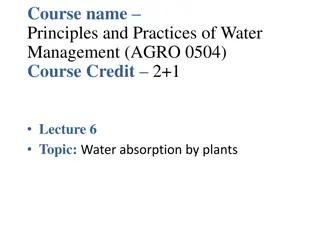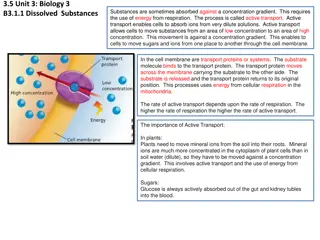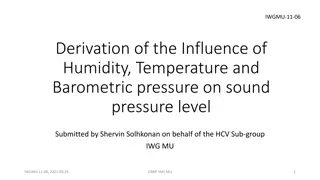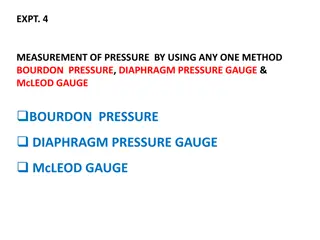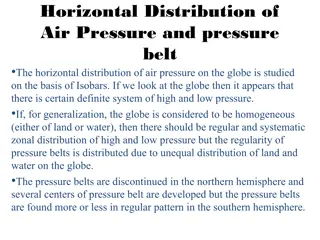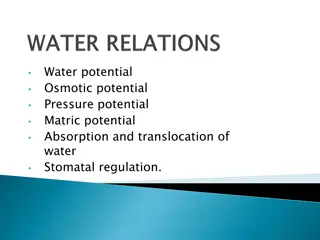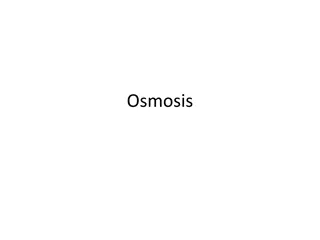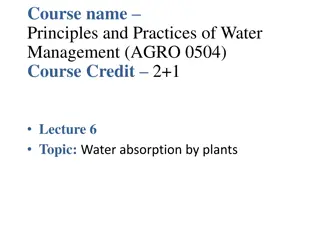Osmosis and Osmotic Pressure
Membranes allowing solvent flow, osmotic pressure, use in determining molar masses, isotonic, hypertonic, hypotonic solutions, saline solution in RBCs.
Download Presentation

Please find below an Image/Link to download the presentation.
The content on the website is provided AS IS for your information and personal use only. It may not be sold, licensed, or shared on other websites without obtaining consent from the author.If you encounter any issues during the download, it is possible that the publisher has removed the file from their server.
You are allowed to download the files provided on this website for personal or commercial use, subject to the condition that they are used lawfully. All files are the property of their respective owners.
The content on the website is provided AS IS for your information and personal use only. It may not be sold, licensed, or shared on other websites without obtaining consent from the author.
E N D
Presentation Transcript
Osmosis and Osmotic Pressure JAVVADI DHARANI SUDHA CLASS XII -A
Osmosis and Osmotic Pressure Certain membranes allow passage of solvent molecules but not solute particles. Such a membrane is called semipermeable. pig s bladder or parchment or synthetic such as cellophane The solvent molecules will flow through the membrane from pure solvent to the solution. This process of flow of the solvent is called osmosis
The osmotic pressure of a solution is the excess pressure that must be applied to a solution to prevent osmosis, i.e., to stop the passage of solvent molecules through a semipermeable membrane into the solution. Osmotic pressure is a colligative property as it depends on the number of solute molecules osmotic pressure is proportional to the molarity, C of the solution at a given temperature T. ?=??? ?=osmotic pressure C=concentration(molarity) R=gas constant T= temperature = v= n2RT V
Osmotic pressure is widely used to determine molar masses of proteins, polymers and other macromolecules. The osmotic pressure method has the advantage over other methods as (1)pressure measurement is around the room temperature (2) the molarity of the solution is used instead of molality (3)As compared to other colligative properties, its magnitude is large even for very dilute solutions (4) osmotic pressure for determination of molar mass of solutes is particularly useful for biomolecules as they are generally not stable at higher temperatures and polymers have poor solubility.
Isotonic ,Hypertonic ,Hypotonic solutions Isotonic solutions : Two solutions having same osmotic pressure at a given temperature are called isotonic solutions Hypotonic solutions: A solution having lower osmotic pressure than the other solution is said to be hypotonic with respect to other solution. Hypertonic solutions: A solution having higher osmotic pressure than the other solution is said to be hypertonic with respect to other solution.
normal saline solution (0.9%aq solution of NaCl) which is isotonic with the fluid inside the human RBC. Therefore during intravenous injection, the medicine are mixed with saline water before injection to prevent the shrinking of the blood cell. The blood cells are placed in a solution containing more than 0.9% (mass/volume) sodium chloride, water will flow out of the cells and they would shrink If the salt concentration is less than 0.9% (mass/volume), water will flow into the cells and they would swell. raw mango placed in concentrated salt solution loses water via osmosis and shrivel into pickle.
Wilted flowers revive when placed in fresh water. A carrot that has become limp because of water loss into the atmosphere can be placed into the water making it firm once again. People taking a lot of salt or salty food experience water retention in tissue cells and intercellular spaces because of osmosis. The resulting puffiness or swelling is called edema The preservation of meat by salting and of fruits by adding sugar protects against bacterial action. Through the process of osmosis, a bacterium on salted meat or candid fruit loses water, shrivels and dies
Reverse Osmosis The direction of osmosis can be reversed if a pressure larger than the osmotic pressure is applied to the solution side ie pure solvent flows out of the solution through the semi permeable membrane. This phenomenon is called reverse osmosis Reverse osmosis is used in desalination of sea water. When pressure more than osmotic pressure is applied, pure water is squeezed out of the sea water through the membrane. Cellulose acetate is permeable to water but impermeable to impurities and ions present in sea water.



